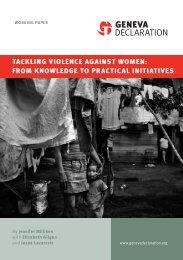Global Burden of Armed Violence - The Geneva Declaration on ...
Global Burden of Armed Violence - The Geneva Declaration on ...
Global Burden of Armed Violence - The Geneva Declaration on ...
You also want an ePaper? Increase the reach of your titles
YUMPU automatically turns print PDFs into web optimized ePapers that Google loves.
60<br />
GLOBAL BURDEN <str<strong>on</strong>g>of</str<strong>on</strong>g> ARMED VIOLENCE<br />
Figure 3.1 Youth populati<strong>on</strong> growth rates and murder rates in the United States, 1950–2005<br />
44%<br />
42%<br />
40%<br />
38%<br />
36%<br />
34%<br />
32%<br />
30%<br />
Box 3.5 <str<strong>on</strong>g>The</str<strong>on</strong>g> demographics <str<strong>on</strong>g>of</str<strong>on</strong>g> discord<br />
From the alleyways <str<strong>on</strong>g>of</str<strong>on</strong>g> Nairobi’s Kibera slum to the cocaine-processing<br />
enclaves <str<strong>on</strong>g>of</str<strong>on</strong>g> Colombia’s highlands and militia encampments in<br />
Darfur, the age <str<strong>on</strong>g>of</str<strong>on</strong>g> violence entrepreneurs is strikingly similar. <str<strong>on</strong>g>The</str<strong>on</strong>g><br />
overwhelming majority <str<strong>on</strong>g>of</str<strong>on</strong>g> those wielding arms are male and less<br />
than 30 years old. This isn’t altogether surprising. Even in developed<br />
countries males are resp<strong>on</strong>sible for four out <str<strong>on</strong>g>of</str<strong>on</strong>g> every five violent<br />
crimes, and the proporti<strong>on</strong> <str<strong>on</strong>g>of</str<strong>on</strong>g> young adults in a society is a fair (but<br />
incomplete) predictor <str<strong>on</strong>g>of</str<strong>on</strong>g> homicide rates (see Figure 3.1). Likewise,<br />
the proporti<strong>on</strong> <str<strong>on</strong>g>of</str<strong>on</strong>g> young adults in a society gives a reas<strong>on</strong>able<br />
indicati<strong>on</strong> <str<strong>on</strong>g>of</str<strong>on</strong>g> a country’s risk <str<strong>on</strong>g>of</str<strong>on</strong>g> stumbling into mass violence.<br />
What is the youth bulge?<br />
<str<strong>on</strong>g>The</str<strong>on</strong>g> youth bulge represents the relatively large proporti<strong>on</strong> <str<strong>on</strong>g>of</str<strong>on</strong>g> young<br />
adults (15 to 29 years <str<strong>on</strong>g>of</str<strong>on</strong>g> age) in a given society. More than 80 per<br />
cent <str<strong>on</strong>g>of</str<strong>on</strong>g> all armed civil c<strong>on</strong>flicts since the 1970s began in countries<br />
where more than 60 per cent <str<strong>on</strong>g>of</str<strong>on</strong>g> the populati<strong>on</strong> was younger than<br />
30. Most other c<strong>on</strong>flicts involved both insurrecti<strong>on</strong>s and the violent<br />
suppressi<strong>on</strong> <str<strong>on</strong>g>of</str<strong>on</strong>g> young populati<strong>on</strong>s. While the age structure <str<strong>on</strong>g>of</str<strong>on</strong>g><br />
a given populati<strong>on</strong> may not necessarily figure in the political and<br />
strategic calculati<strong>on</strong>s that pave the way to war, their mobilizati<strong>on</strong><br />
is <strong>on</strong>e ingredient that, together with capital availability, arms<br />
supplies, grievances, and state weaknesses, completes the recipe.<br />
When plotted graphically, the pr<str<strong>on</strong>g>of</str<strong>on</strong>g>ile <str<strong>on</strong>g>of</str<strong>on</strong>g> the youthful populati<strong>on</strong> is<br />
easily identified and distinguished from more mature <strong>on</strong>es. It<br />
appears broadly pyramidal, providing a hint <str<strong>on</strong>g>of</str<strong>on</strong>g> the magnitude <str<strong>on</strong>g>of</str<strong>on</strong>g><br />
the challenges that developing states face in providing adequate<br />
public services. Typically, countries with pyramidal age structures<br />
experience growth rates in working age populati<strong>on</strong>s <str<strong>on</strong>g>of</str<strong>on</strong>g> three to<br />
Percentage <str<strong>on</strong>g>of</str<strong>on</strong>g> young adults (15–29 years)<br />
in the working-age populati<strong>on</strong> (15–64 years)<br />
Legend: Young adults Murder rate<br />
Sources: Cohen and Land (1987);<br />
US Department <str<strong>on</strong>g>of</str<strong>on</strong>g> Justice Statistics<br />
four per cent (compared to about 1 per cent in the United States).<br />
An abundance <str<strong>on</strong>g>of</str<strong>on</strong>g> adolescents and young adults tends to promote<br />
a vibrant and experimental youth culture. When this large group<br />
matures into its working years, it tends to saturate the job market,<br />
depressing wages and exacerbating unemployment. As a society’s<br />
agricultural sector declines and urbanizati<strong>on</strong> intensifies, inequalities<br />
rapidly emerge.<br />
Declines in women’s fertility dramatically alter this pr<str<strong>on</strong>g>of</str<strong>on</strong>g>ile. 9 As a<br />
rule, youth bulges appear in countries that have experienced high<br />
fertility rates 20 years previously. Because a bulge dissipates <strong>on</strong>ly<br />
after about two decades <str<strong>on</strong>g>of</str<strong>on</strong>g> fertility decline, today—despite the<br />
spread <str<strong>on</strong>g>of</str<strong>on</strong>g> modern c<strong>on</strong>tracepti<strong>on</strong>—15- to 29-year-olds still comprise<br />
more than 40 per cent <str<strong>on</strong>g>of</str<strong>on</strong>g> the working-age populati<strong>on</strong> (15 to 64) in<br />
over half the world’s countries. Most are in sub-Saharan Africa,<br />
the Andes in South America, Central and South Asia, and the<br />
Pacific Islands.<br />
Youthful risks<br />
A youthful society c<strong>on</strong>stitutes a potential risk, rather than a cause,<br />
<str<strong>on</strong>g>of</str<strong>on</strong>g> the <strong>on</strong>set <str<strong>on</strong>g>of</str<strong>on</strong>g> collective armed violence. Since the 1960s, there<br />
has been growing awareness that those countries with a large<br />
proporti<strong>on</strong> <str<strong>on</strong>g>of</str<strong>on</strong>g> young adults have an elevated risk <str<strong>on</strong>g>of</str<strong>on</strong>g> experiencing<br />
the emergence <str<strong>on</strong>g>of</str<strong>on</strong>g> a new civil c<strong>on</strong>flict, political violence, and domestic<br />
terrorism. 10 Comparative studies indicate that the risk <str<strong>on</strong>g>of</str<strong>on</strong>g> c<strong>on</strong>flict<br />
associated with a large youth bulge is roughly comparable to risks<br />
associated with low levels <str<strong>on</strong>g>of</str<strong>on</strong>g> per capita income or high levels <str<strong>on</strong>g>of</str<strong>on</strong>g> infant<br />
mortality—around 2.3 times that <str<strong>on</strong>g>of</str<strong>on</strong>g> other intervening variables. 11<br />
Political demographers hypothesize that a large youth bulge facilitates<br />
youth political mobilizati<strong>on</strong> and more formal recruitment<br />
into state and n<strong>on</strong>-state forces and criminal networks. ##<br />
Murders per 100,000 populati<strong>on</strong><br />
1950 1955 1960 1965 1970 1975 1980 1985 1990 1995 2000 2005<br />
11.0<br />
10.0<br />
9.0<br />
8.0<br />
7.0<br />
6.0<br />
5.0<br />
4.0









